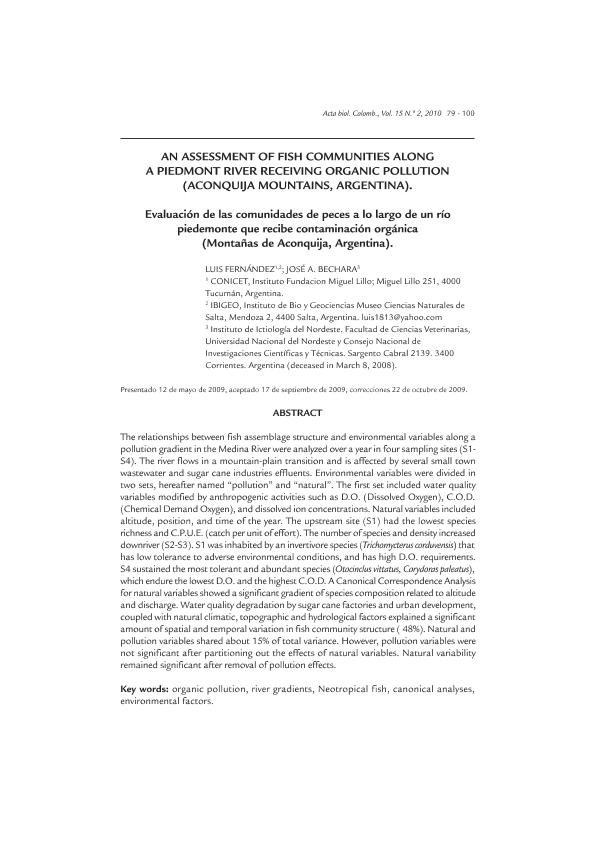Artículo
An assessment of fish communities along a piedmont river receiving organic pollution (Aconquija Mountains, Argentina)
Fecha de publicación:
09/2010
Editorial:
Universidad Nacional de Colombia
Revista:
Acta Biologica Colombiana
ISSN:
1900-1649
Idioma:
Inglés
Tipo de recurso:
Artículo publicado
Clasificación temática:
Resumen
The relationships between fish assemblage structure and environmental variables along a pollution gradient in the Medina River were analyzed over a year in four sampling sites (S1-S4). The river flows in a mountain-plain transition and is affected by several small town wastewater and sugar cane industries effluents. Environmental variables were divided in two sets, hereafter named “pollution†and “naturalâ€. The first set included water quality variables modified by anthropic activities such as D.O., C.O.D, and dissolved ion concentrations. Natural variables included altitude, position, and time of the year. The upstream site (S1) had the lowest species richness and CPUE; but the number of species and density increased downriver (S2-S3). S1 was inhabited by invertivore species (Trichomycterus corduvensis), having low tolerance to environmental conditions and high D.O. requirements. S4 sustained the most tolerant and abundant species (Otocinclus vittatus, Corydoras paleatus), enduring the lowest D.O. and the highest C.O.D. A significant Canonical Correspondence Analysis for natural variables showed a gradient of species composition related to altitude and discharge. Water quality degradation by sugar cane factories and urban development, coupled with natural climatic, topographic and hydrological factors explained a significant amount of spatial and temporal variation in fish community structure (@48%). Natural and pollution variables shared about 15% of total variance. However, pollution variables were not significant after partialling- out the effects of natural variables, but natural variability remained significant after removal of pollution effects. The results suggest that effects of pollution may be just the result of ordination of fish communities along natural spatial and temporal gradients that are positively correlated to pollution gradients.
Palabras clave:
Organic Pollution
,
River Gradients
,
Neotropical Fish
,
Canonical Analyses
Archivos asociados
Licencia
Identificadores
Colecciones
Articulos(CCT - NOA SUR)
Articulos de CTRO.CIENTIFICO TECNOL.CONICET - NOA SUR
Articulos de CTRO.CIENTIFICO TECNOL.CONICET - NOA SUR
Citación
Fernandez, Luis Alfredo; Bechara, Jose Alfredo; An assessment of fish communities along a piedmont river receiving organic pollution (Aconquija Mountains, Argentina); Universidad Nacional de Colombia; Acta Biologica Colombiana; 15; 2; 9-2010; 1-37
Compartir




